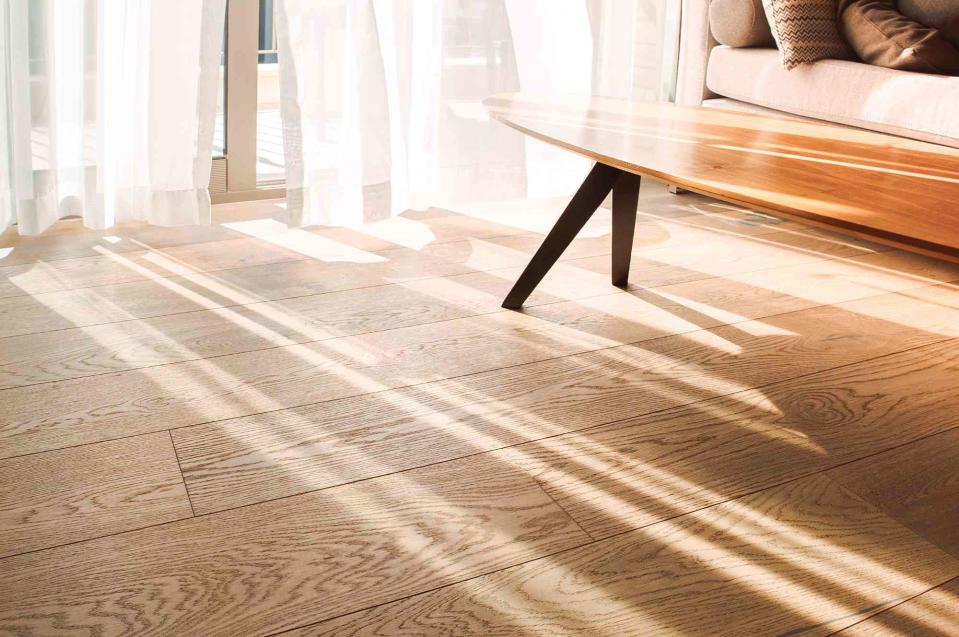The Right Way to Clean Vinyl Plank Flooring
Get your vinyl flooring sparkling clean using this tried-and-true method.

Vinyl plank flooring is a low-cost, low-maintenance flooring option that can make a big impact on the look of your home. But like all floors, the material requires regular maintenance to ensure it stays looking its best. While vinyl plank flooring is easy to sanitize with a vacuum and mop, washing it incorrectly can warp and ruin your floors. Follow these tips to perfect the process—while avoiding costly cleaning mistakes—and keep your floors dirt-free, stain-free, and as flat as the day they were installed.
Meet the Expert
Melissa Homer, chief cleaning officer at MaidPro
Marla Mock, president of Molly Maid
Related: How to Clean Every Type of Floor—and Keep It Spotless
How Often to Clean Vinyl Plank Flooring
Like the other floors in your home, you should plan to remove crumbs, dust, and debris from your floors at least once a week. If you have kids or pets, live in a place where mud, snow, and dirt are likely to get tracked in on your shoes, or have household members coming home from especially dirty work sites, you may need to sweep or vacuum more often.
All hard floors, vinyl or otherwise, should be mopped to match the frequency of the foot traffic in the room, says Melissa Homer, chief cleaning officer at MaidPro. "For most homes, high-traffic rooms like the kitchen, bathroom, and front entryway should be mopped weekly to every other week," she says. "Less frequented rooms, like a formal dining room, can be mopped every two to four weeks, depending on use."
Warning
Avoid using string mops and steam mops, which can cause water damage on vinyl plank flooring.
Tools and Materials
Vinyl flooring is easy to maintain, but you should be selective about the tools you use. "If you choose to vacuum, make sure your vacuum is on the floor setting, which will prevent scratches," says Marla Mock, president of Molly Maid. For mopping, avoid using string mops and steam mops, which can cause water damage—vinyl plank floors, even those that claim to be waterproof, are not often water resistant at the seams, says Homer. Vinyl flooring is not scratch-resistant, so don't use anything scratchier than the scrubbing back of a nonabrasive kitchen sponge.
With those factors in mind, these are the tools and materials you'll need when cleaning vinyl plank flooring:
Broom or vacuum
Microfiber mop
Vinegar
Water
Dish soap
Microfiber cloth
Baking soda
How to Clean Vinyl Plank Flooring
A broom or vacuum and a damp-mopping technique allow you to keep your floors spic-and-span without risking water damage. The most important thing to remember when cleaning vinyl plank flooring is never to leave puddles or let the floor get sopping wet, as water can absorb and ruin the underlayment and base flooring underneath, says Homer.
Prepare for deep cleaning by removing loose crumbs, dirt, and pet hair.
Tackle scuff marks with a damp microfiber cloth (which you can use to buff out the discoloration).
In a spray bottle, combine 1 cup vinegar, 1 cup hot water, and 2 to 3 drops of dish soap.
Wet and thoroughly wring out your microfiber flat mop pad with fresh warm water.
Working in 3-foot-square sections, spray the floor with a light, even mist of the cleaning solution, and mop immediately with the damp head.
Repeat the process as you move across the room. If the mop head is too dirty or wet, rinse and wring it out as needed.
Use a clean towel after mopping to fully dry the floor since excess water can warp vinyl.
How to Remove Stains from Vinyl Plank Flooring
For hard-to remove stains like caked-on food, ink, paint, or other messes, a baking soda paste should do the trick, says Mock.
Mix together baking soda and water until it forms a paste.
Use a soft cloth to rub the stain out of the vinyl floor.
While this method will remove stains from vinyl plank flooring, it's best to clean them as soon as possible. "Keeping brooms and dust pans near the floors, often stashed in closets, to remind you to keep them clean is helpful," says Mock. "A good rule of thumb is, if you can clean it in two minutes or less, clean it right away."
Read the original article on Martha Stewart.

